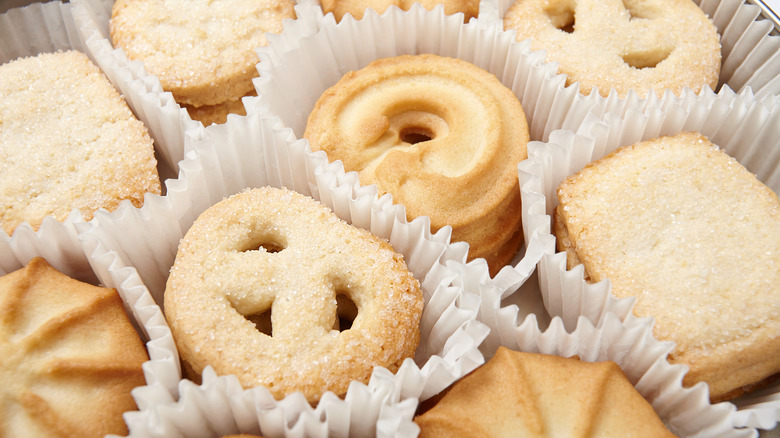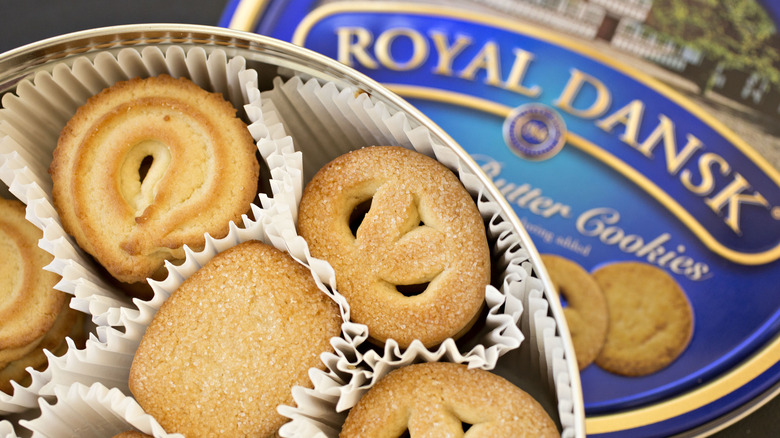Is There A Difference Between Butter Cookies And Shortbread?
Butter is an essential ingredient in baking, and in cookies like shortbread, sugar cookies, and of course, butter cookies, this versatile cooking fat takes a leading role. Sugar cookies are often defined by icing, sprinkles, and other decorations, but basic shortbread and butter cookies — which are both simple, slightly crumbly and crisp, and with little to no adornments — seem almost identical. Are there any differences? The short answer is yes, and the longer answer is a bit more involved. The difference between these cookies come down to the ratios of flour, eggs, and sugar.
Due to differing ratios, shortbread cookies are crumblier and more "sandy" than butter cookies, which are firm and solid enough to be iced. This mostly has to do with flour and eggs. Shortbread doesn't use eggs, while butter cookies do, making butter cookie dough more pliable and robust than its shortbread counterpart. For all the differences between these two cookies, their common ground is that they use lots of butter. So, if you're whipping up a batch of shortbread cookies or baking these best-ever butter cookies, you'll want to use high-quality butter.
History of shortbread
Shortbread is a crumbly, melty, biscuit-like cookie that can be made with butter, flour, and sugar alone. Compared to butter cookies, shortbread uses a higher ratio of butter to flour, and is baked at a lower temperature. This gives it its signature delicate consistency that crumbles in the mouth when bitten. It's also often baked in a pan and cut up after baking, rather than being cut into shapes before baking.
Shortbread has origins in medieval Europe, and began as a baked good called "biscuit bread." This was made from leftover yeasted bread dough that was dried out into a crisp, toast-like product. Eventually, yeast was dropped and butter was added, resulting in an early form of shortbread, the buttery biscuit we know today.
Mary, Queen of Scots, was reportedly a big fan of shortbread, and it's been believed that the cookie's rise to fame in the 16th century is tied to her royal highness' love for them. However, these cookies date as far back as the 12th century, during the rule of Queen Elizabeth I. Triangular pieces of shortbread were called "petticoat tails," and some historians speculate that this is because when arranged together, the biscuits resembled a full petticoat. Over the centuries, shortbread has held on as a staple of Scottish and English tradition as a biscuit synonymous with Christmas and New Year's.
History of butter cookies
Like shortbread, butter cookies use a lot of butter, but contain more flour and sugar. They hold their shape better, making them suitable for cutting into shapes and decorating with royal icing or other accoutrements. Sometimes, the dough is piped out into shapes using a pastry bag before being baked, resulting in appealing swirl shapes or other creative looks.
The origins of butter cookies are a little more obscure, but it's likely that the recipe was brought to America by early English, Scottish, and Dutch settlers. One of the most popular makers of butter cookies is Denmark's Royal Dansk bakery. They manufacture the iconic blue tins of butter cookies that you can buy at countless stores (the ones that your grandma likely stored sewing supplies in after the cookies were eaten).
Butter cookies, not unlike shortbread, have become synonymous with the holiday season. Not only are they delicious, but they're an easy gift to give and equally easy to receive (and devour). Whether you're picking up one of those blue shortbread tins at the store, or you make them yourself, you can't really go wrong with these sweet, buttery treats.


